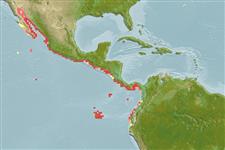>
Eupercaria/misc (Various families in series Eupercaria) >
Lutjanidae (Snappers) > Lutjaninae
Etymology: Hoplopagrus: Greek, hoplon = weapon + Greek, pagros = a fish, Dentex sp. (Ref. 45335).
More on author: Gill.
Environment: milieu / climate zone / depth range / distribution range
Ecología
marino asociado a arrecife; rango de profundidad 0 - 50 m (Ref. 55763). Tropical; 35°N - 5°S, 120°W - 76°W
Eastern Pacific: Mexico to Colombia.
Tamaño / Peso / Age
Maturity: Lm ? range ? - ? cm
Max length : 92.0 cm TL macho / no sexado; (Ref. 9313); common length : 50.0 cm TL macho / no sexado; (Ref. 9313); peso máximo publicado: 9.6 kg (Ref. 40637)
Espinas dorsales (total): 10; Radios blandos dorsales (total): 14; Espinas anales 3; Radios blandos anales: 9. Body deep and compressed; anterior profile of head slightly sloping and somewhat convex; snout prominent; anterior nostril tubular; posterior nostril embedded in a deep furrow; preopercle deeply notched; vomerine and lateral jaw teeth molariform; lower branch of first gill arch with 11 to 15 gill rakers; dorsal scale series running parallel to lateral line; back greenish brown; belly pink; flanks with 8 brownish blue vertical bars (Ref. 55763). Post-opercular notch and knob strong; anterior nostril long and tubular. Scale rows on back running parallel to the lateral line. Color is greenish with a series of about eight bars on sides.
Adults are encountered generally over rocky bottoms in the vicinity of coral reefs, up to at least 40 or 50 m (Ref. 9313). Juveniles may penetrate rocky littoral pools (Ref. 9313). Carnivorous, feed on fishes and invertebrates of the bottom (Ref. 9313). Caught with handlines and marketed fresh (Ref. 9313).
Life cycle and mating behavior
Madurez | Reproducción | Puesta | Huevos | Fecundidad | Larva
Allen, G.R., 1985. FAO Species Catalogue. Vol. 6. Snappers of the world. An annotated and illustrated catalogue of lutjanid species known to date. FAO Fish. Synop. 125(6):208 p. Rome: FAO. (Ref. 55)
IUCN Red List Status (Ref. 130435)
Threat to humans
Harmless
Human uses
Pesquerías: pesquerías de subsistencia; pesca deportiva: si; Acuario: Acuarios públicos
Más información
Nombres comunesSinónimosMetabolismoDespredadoresEcotoxicologíaReproducciónMadurezPuestaAgregación para la puestaFecundidadHuevosEgg development
ReferenciasAcuiculturaPerfil de acuiculturaRazasGenéticaElectrophoresesheritabilidadEnfermedadesProcesamientoNutrientsMass conversion
Herramientas
Special reports
Download XML
Fuentes de Internet
Estimates based on models
Preferred temperature (Ref.
123201): 20.6 - 28.5, mean 25.2 °C (based on 54 cells).
Phylogenetic diversity index (Ref.
82804): PD
50 = 1.0000 [Uniqueness, from 0.5 = low to 2.0 = high].
Bayesian length-weight: a=0.01479 (0.00709 - 0.03087), b=2.97 (2.80 - 3.14), in cm total length, based on LWR estimates for this (Sub)family-body shape (Ref.
93245).
Nivel trófico (Ref.
69278): 3.8 ±0.0 se; based on diet studies.
Resiliencia (Ref.
120179): Bajo, población duplicada en un tiempo mínimo de 4.5-14 años (Preliminary K or Fecundity.).
Fishing Vulnerability (Ref.
59153): High vulnerability (57 of 100).
Nutrients (Ref.
124155): Calcium = 23.7 [14.3, 40.5] mg/100g; Iron = 0.445 [0.244, 0.772] mg/100g; Protein = 19.1 [17.3, 20.8] %; Omega3 = 0.123 [0.082, 0.187] g/100g; Selenium = 38.8 [24.0, 66.3] μg/100g; VitaminA = 60.5 [21.2, 184.1] μg/100g; Zinc = 0.896 [0.654, 1.232] mg/100g (wet weight);
